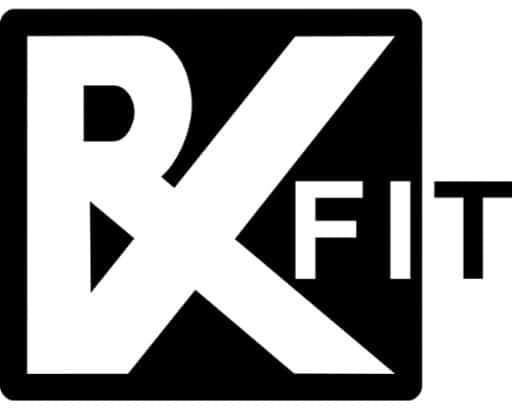Carrying groceries up the stairs, reaching for something on a high shelf, or playing with your kid are simple actions that reveal how well your body handles day to day life. Functional fitness is all about training your body to move efficiently in these moments.
So, what is functional fitness, really? It’s a way of exercising that focuses on movements you use daily, making day to day life easier and more comfortable.
In this article, you’ll find out the benefits of functional fitness, its core elements, and practical exercises to get you started. This approach can change the way you move, so let’s get into it.
Key Takeaways
- Functional fitness emphasizes real-life movements, improving overall mobility and foundational strength for everyday tasks.
- Key components of functional fitness include strength, balance, coordination, mobility, and range of motion, which together improve physical capability and enhance the body’s ability to perform daily tasks.
- Unlike traditional strength training, functional fitness focuses on compound exercises that engage multiple muscle groups, making it accessible and beneficial for all fitness levels.
Understanding Functional Fitness
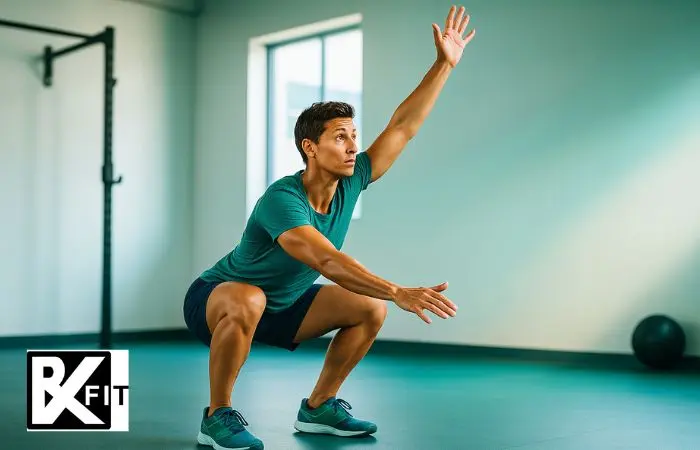
Functional fitness is a training method centered on real-life movements. Unlike traditional strength training, which often isolates muscles through exercises like the bicep curl, functional fitness focuses on improving how you handle everyday activities.
It uses compound movements known as functional exercises that engage multiple muscle groups at once, blending elements of functional bodybuilding, exercise, and movement training.
The main aim is to boost mobility and foundational strength, preparing your body for tasks like lifting, carrying, reaching, and bending by simulating common movements such as squatting, reaching, and lifting.
Functional exercises mimic the movements you use daily, whether it is squatting to pick something up or reaching overhead to place an item on a shelf. This way, your muscles learn to work together smoothly.
What makes functional fitness different from conventional strength training is its focus on movement quality rather than just lifting heavier weights. This coordination and stability helps engage several muscle groups simultaneously, improving overall fitness and lowering injury risk.
Components of Functional Fitness
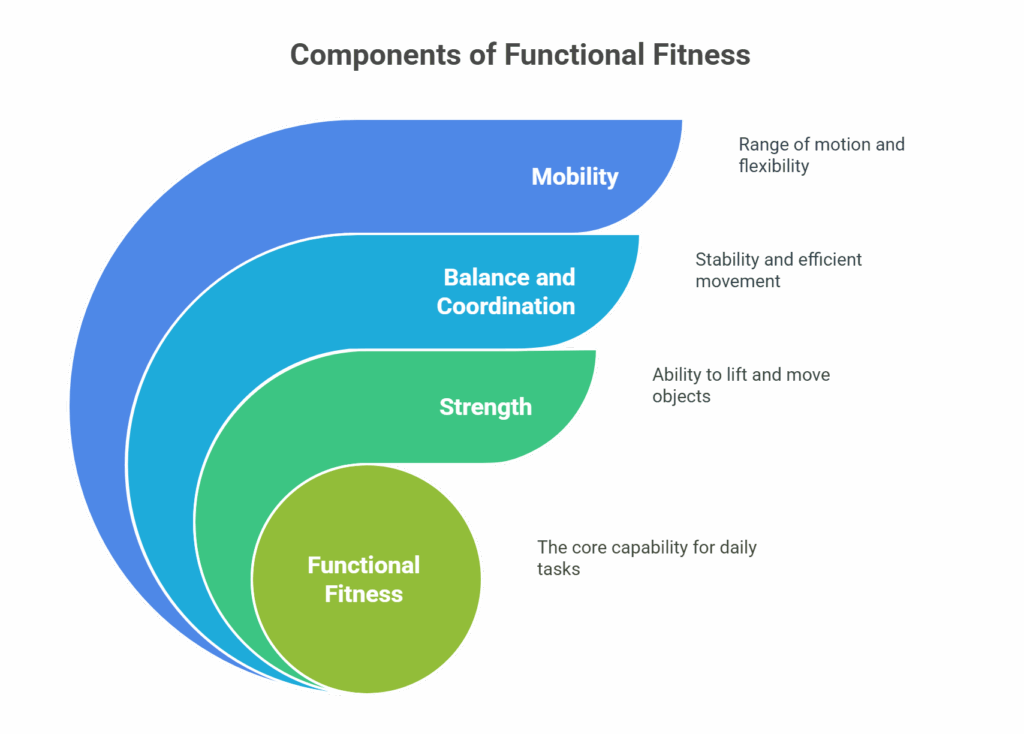
Think about reaching for a heavy box on a high shelf or steadying yourself on an uneven sidewalk. These everyday moments rely on several key components of functional fitness working together seamlessly: strength, balance, coordination, power, range of motion, and mobility.
Strength lets you lift, push, and pull with ease. Functional strength training targets multiple muscle groups and joints at once, mirroring real-life movements and meaningful tasks rather than isolating a single muscle.
Balance and coordination keep you steady and prevent falls. Many functional exercises include balance work to help your body move safely and efficiently. Core stability is also crucial, as it helps maintain proper form and movement efficiency during these exercises.
Mobility, which covers both range of motion and flexibility, is just as important. Better mobility means you can move more freely and with less risk of strain or injury. It supports balance and coordination, making everyday activities smoother and less taxing.
Together, these components build a body that’s not only stronger but also more capable of handling whatever daily life throws your way.
Evolution of Functional Fitness
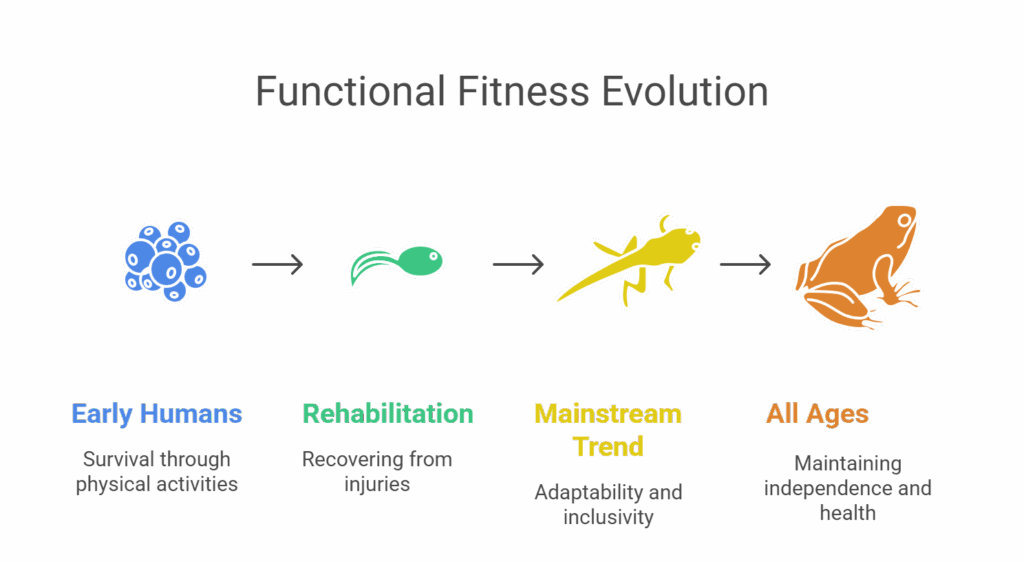
The concept of functional fitness is rooted in the survival practices of early humans. Hunting, gathering, and other daily activities required the use of various body movements and tools, essentially practicing functional fitness without even knowing it.
These survival practices played a significant role in human evolution, helping individuals adapt to their environment and develop the physical capabilities needed for survival.
As society evolved, so did the approach to fitness. Functional fitness has transitioned from its origins in rehabilitation and physical therapy to become a mainstream fitness trend.
Initially used in physical therapy to help individuals recover from injuries and improve their ability to perform daily tasks, functional fitness is now embraced by people of all ages and fitness levels for its broad benefits. Its adaptability and inclusivity make it suitable for everyone, from young athletes to older adults seeking to maintain their independence and overall health.
Benefits of Functional Fitness
Functional fitness helps improve your overall well-being by offering a range of benefits that extend far beyond the gym. In fact, life can feel less taxing with it. This training method doesn’t just build strength; it improves how your body moves through everyday life activities, making tasks like carrying, lifting, and bending easier and less stressful.
Functional fitness workouts sharpen your ability to perform routine movements, boosting your overall functional capabilities. These workouts also reinforce proper movement patterns, which helps reduce the risk of injury over time.
One of its standout benefits is its low-impact nature, making it accessible for all fitness levels. Whether you’re just starting out or have years of experience, functional fitness adapts to your needs, helping improve muscle memory, flexibility, posture, and motor control.
Beyond these, functional fitness supports overall physical health. It eases stiffness, enhances joint function, and improves balance and coordination. At the end, what you get is a more active, healthier lifestyle where everyday tasks feel natural and manageable.
Functional Fitness Exercises
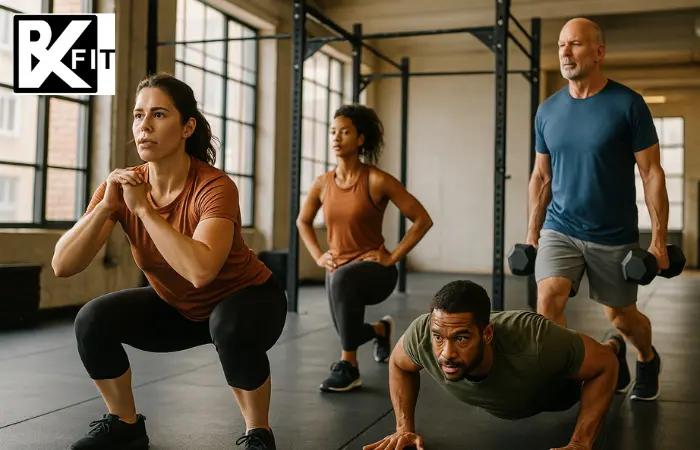
Functional fitness exercises are the building blocks that strengthen your body’s everyday movements. They can be likened to the gears in a well-oiled machine, working together to keep you moving smoothly through daily tasks.
These exercises focus on multi-joint movements that support both strength and flexibility, simulating real-life actions like bending, lifting, and reaching.
Common staples like bodyweight squats, push-ups, and lunges act like rehearsals for your body’s daily performance, preparing you for whatever comes next. For beginners, starting with bodyweight training exercises can appear simple, yet essential.
Moves such as box step-ups, dumbbell bench presses, Romanian deadlifts, and farmer’s carries build core strength and stability, setting up the body for more complex challenges. The variety of exercises performed in functional fitness routines ensures you develop overall strength, balance, and mobility for daily life activities.
As you advance, variations like reverse lunges, lateral lunges, and single-leg squats add new layers to your routine, engaging different muscle groups and turning up the intensity.
Thankfully, you can modify these training exercises to fit your level. For example, planks become side planks or shoulder taps, and seated leg extensions offer a gentler alternative to squats for those needing extra support.
Adding tools like resistance bands and medicine balls enriches your workout with resistance and variety. Whether you’re just starting out or well into your fitness journey, functional fitness exercises can be tailored to fit your unique needs, helping you build a body that’s not just strong, but ready for life’s every move.
Getting Started with Functional Fitness
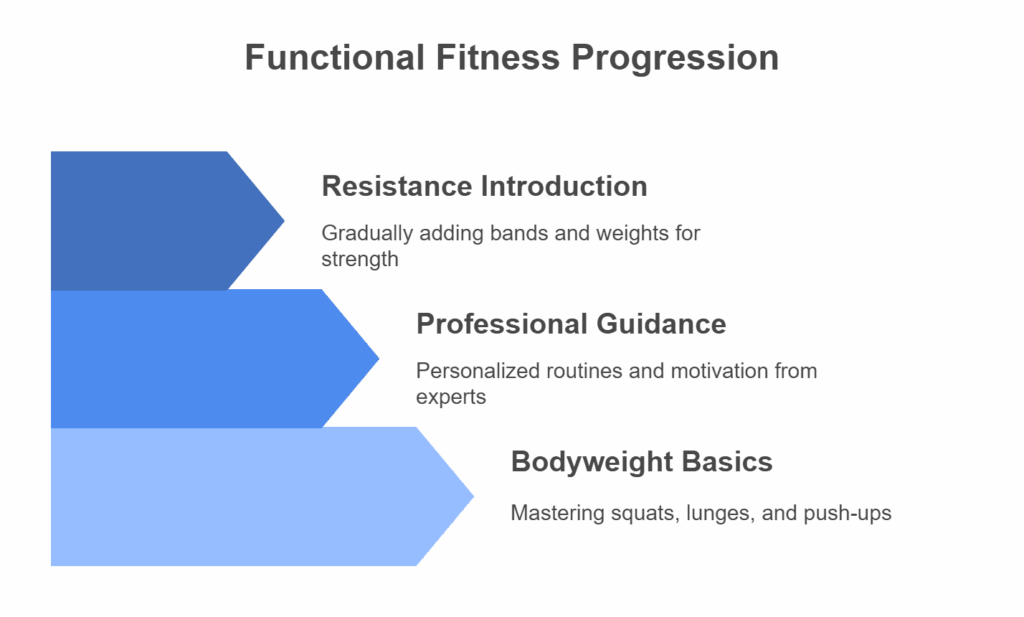
Getting started with functional fitness can be both exciting and rewarding. For beginners, the key is to focus on mastering bodyweight exercises and functional training exercises before adding resistance.
Starting position with exercises that use only your body weight, such as functional training exercises, helps you learn proper form and develop foundational strength. Simple movements like squats, lunges, and push-ups are excellent starting points.
Additionally, consulting a fitness professional can provide personalized guidance and accountability. A fitness professional can:
- Help you learn proper form,
- Create a tailored exercise routine,
- Provide motivation to stay consistent,
- Introduce you to balance training, which is fundamental for ensuring safe movement patterns during workouts.
As you become more comfortable with bodyweight exercises, you can gradually increase resistance by introducing tools like resistance bands and weights. They are a safe way to develop strength gradually, while targeting different muscle groups.
Functional Fitness vs. Traditional Strength Training
Functional fitness and traditional strength training both have their unique benefits, but functional fitness differ significantly in their approach and focus. Functional training focuses on movements that replicate real-life activities, improving overall body mechanics and stability. In contrast, traditional strength training often focuses on isolated muscle development and maximal strength.
One key difference is the type of exercises used. A functional training workout utilizes compound exercises that engage multiple muscle groups simultaneously, mimicking real-life movements.
Traditional strength training, on the other hand, often involves isolation exercises targeting a specific muscle group to achieve hypertrophy, gain muscle mass, and improve muscle definition. This approach frequently emphasizes lifting heavy weights to maximize muscle growth and strength.
While both methods can improve strength, functional fitness aims to enhance mobility and coordination, making it more applicable to everyday tasks.
Another notable difference is the accessibility and equipment requirements. Functional strength training requires minimal equipment and can be adapted to various fitness levels, making it accessible to a wide audience.
Traditional strength training typically involves lifting heavy weights in a controlled manner, focusing on progressive overload to ensure systematic muscle growth.
Understanding these differences helps you choose the approach that best aligns with your fitness goals and lifestyle.
Functional Fitness for Injury Prevention
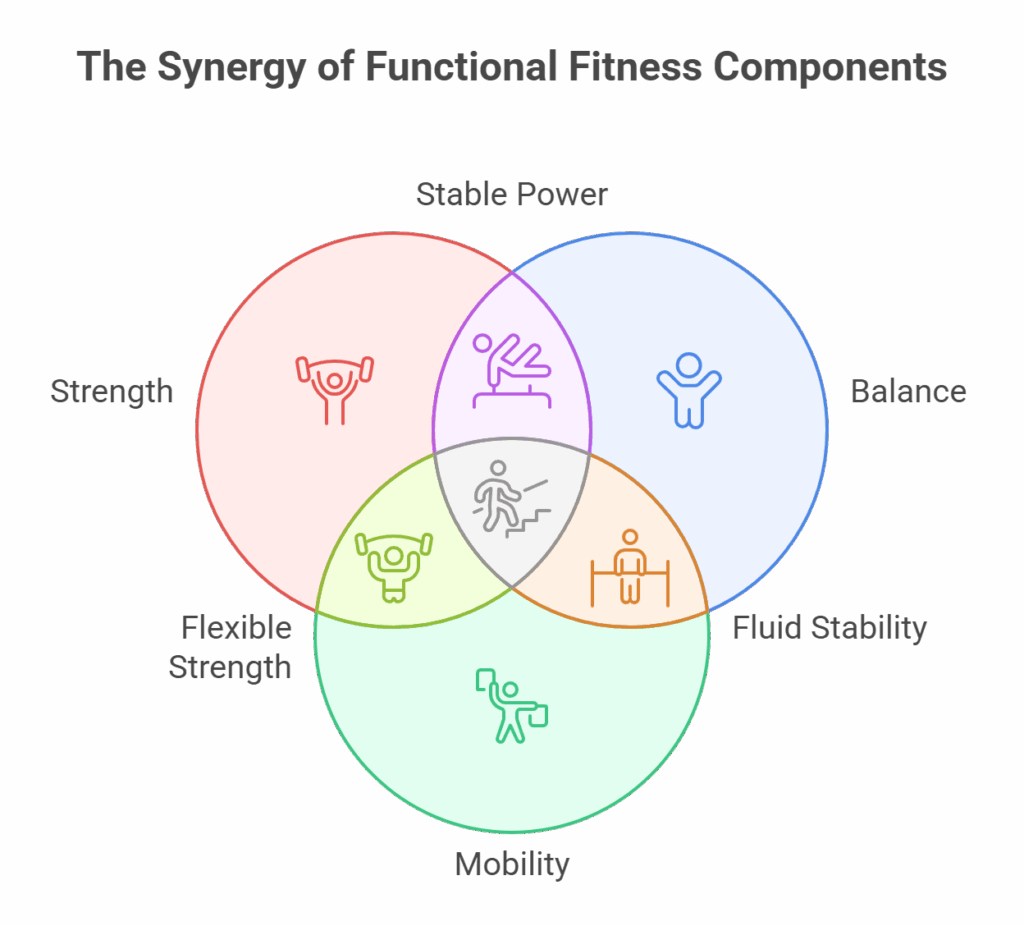
Functional fitness serves as a finely tuned safety net, catching you before injuries occur. By mimicking real-life actions, it improves your overall movement patterns, making everyday tasks smoother and safer.
This training focuses on three key areas which are: strength, balance, and mobility, working together to reduce the risk of injury during daily activities.
Strength training helps muscles work in harmony, easing strain and lowering injury chances. Balance exercises are essential for maintaining stability and preventing falls, especially as you age. Improving range of motion through mobility work allows for greater flexibility and movement efficiency, further minimizing injury risk.
Proper warm-ups prepare your body gently for exercise, reducing the likelihood of strains and sprains. Functional fitness also reinforces healthy movement patterns, protecting joints and reducing stress.
Incorporating these practices into your routine builds a resilient body that guards against daily injuries while developing your overall functional capacity.
Incorporating Functional Fitness into Your Routine
Incorporating functional fitness into your workout routine is easier than you might think. Start by aiming for a mix of exercises that work the legs, arms straight, and core. Your workouts should also involve training that integrates both traditional and functional movements, helping prepare your body for real-life activities and improving overall functionality. This approach ensures that all major muscle groups are engaged, promoting overall strength and stability for the whole body.
You might also consider scheduling specific days for functional workouts to ensure a well-rounded training program throughout the week.
Consistency is key when adding functional fitness to your routine. Regular practice increases the effectiveness of your workouts and improves your ability to perform everyday tasks with ease.
To keep your routine engaging, vary your exercises and include different types of functional movements. This variety keeps your workouts interesting and also ensures that you’re continually challenging your body in new ways.
Functional Fitness in Different Settings
Functional fitness fits into a variety of settings, making it a flexible and adaptable way to stay active. Take RX Fit classes, for example. They blend functional movements into high-intensity workouts that boost overall fitness. Similarly, HIIT classes often weave in functional exercises to build strength while improving cardiovascular health. For those seeking a more specialized group workout, functional fitness classes are available at many gyms, focusing specifically on functional movements and often tailoring exercises to individual needs within a group setting.
Specialized gyms like F45 focus on circuit training designed to ease everyday movements and engage multiple muscle groups. These classes offer structure, professional guidance, and a supportive community, while individualized training allows exercises to be tailored to your personal abilities for steady progress.
The good news is, you don’t need a gym to practice functional fitness. It can be done at home with minimal equipment. Resistance bands, medicine balls, and bodyweight exercises are all effective tools to build functional strength and mobility.
This versatility ensures functional fitness is accessible to everyone, no matter your fitness level or resources. Exploring different settings helps you find the approach that fits your lifestyle and goals best.
Summary
Functional fitness shifts the focus of training to real-life movements, emphasizing multi-joint exercises that engage multiple muscle groups simultaneously. As earlier discussed, this approach builds strength, stability, and mobility, making everyday tasks easier and more efficient by preparing you for common movements such as squatting, reaching, pulling, and lifting encountered in daily life. Its benefits reach beyond the gym, improving the quality of life and reducing injury risk.
Whether you prefer specialized sessions at RX Fits or home workouts, functional fitness adapts to fit your needs and goals. Embrace this versatile method to improve your overall functional capacity and well-being.
Frequently Asked Questions
What is the focus of functional fitness training?
Functional fitness training focuses on developing strength, flexibility, balance, and coordination through real-life movement patterns, ultimately improving overall physical performance.
What are some benefits of functional strength training?
Functional strength training offers numerous benefits, such as reduced joint pain, enhanced balance and coordination, and increased flexibility and mobility. These improvements contribute to better overall posture and a decreased risk of injuries.
What types of exercises can be incorporated into a functional fitness routine?
Incorporate exercises that mimic daily movements, such as squats, lunges, and weightlifting, to enhance your functional fitness routine effectively. These movements not only increase strength but also improve overall mobility and functionality in everyday tasks.
What is functional bodybuilding?
Functional bodybuilding combines functional fitness and bodybuilding principles to enhance strength and improve movement patterns effectively. It’s a holistic approach that prioritizes both performance and aesthetics.
What components are essential for functional fitness?
To achieve functional fitness, it’s crucial to focus on strength, balance, coordination, power, range of motion, and mobility. These components work together to enhance overall physical performance and daily activity efficiency.
